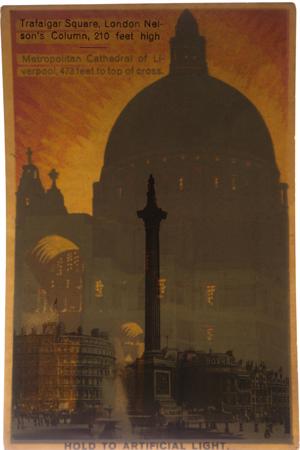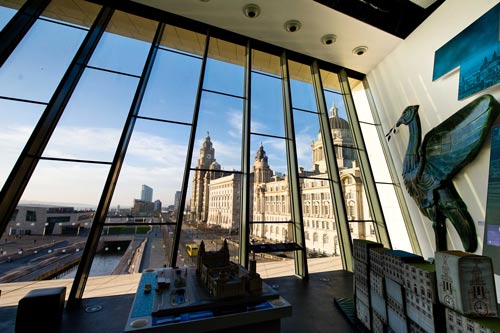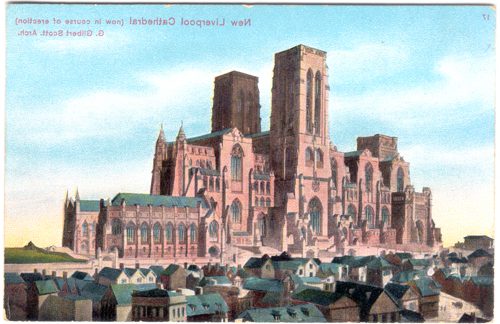The making of the cityscape

I was honoured to be among the first people to see the astounding views from the Museum of Liverpool's second floor windows. I visited the building when it was still a building site, and the windows hadn't even been put in! I'd been working on plans of the galleries for years but this hadn't prepared me for the beautiful views on a bright sunny day. It was literally breath-taking, my gasp was audible!
 View from The People's Republic in Museum of Liverpool. Image Ant Clausen
The passage of time has brought great love for iconic buildings of Liverpool, including the Liver Building, seen from The People's Republic gallery, the Albert Dock, seen from the Wondrous Place gallery, the cathedrals, and Oriel Chambers. These buildings were not always such accepted elements of Liverpool. When any bold new building is added to the city it will have a great impact, which may be loved by some, but perhaps disliked by others.
A Professor of Architecture and the Liver Building
Charles Reilly, Professor of Architecture at the University of Liverpool was not a fan of the Liver Building, describing it as, "the hideously irregular Liver pile"! Indeed, he wrote-off the whole Liverpool waterfront, "with this hopelessly unbalanced and indeed ridiculous collection of buildings as seen from the river for its conception of a gateway to Europe, it almost deserved to lose, as it has done, the great Atlantic liners" (Reilly 1923, 55).
The Liver Building is now a favourite building for many people, and was voted among the top ten buildings in Liverpool in a Liverpool Echo poll in 2014.
What would the Anglican Cathedral look like with two central towers?
View from The People's Republic in Museum of Liverpool. Image Ant Clausen
The passage of time has brought great love for iconic buildings of Liverpool, including the Liver Building, seen from The People's Republic gallery, the Albert Dock, seen from the Wondrous Place gallery, the cathedrals, and Oriel Chambers. These buildings were not always such accepted elements of Liverpool. When any bold new building is added to the city it will have a great impact, which may be loved by some, but perhaps disliked by others.
A Professor of Architecture and the Liver Building
Charles Reilly, Professor of Architecture at the University of Liverpool was not a fan of the Liver Building, describing it as, "the hideously irregular Liver pile"! Indeed, he wrote-off the whole Liverpool waterfront, "with this hopelessly unbalanced and indeed ridiculous collection of buildings as seen from the river for its conception of a gateway to Europe, it almost deserved to lose, as it has done, the great Atlantic liners" (Reilly 1923, 55).
The Liver Building is now a favourite building for many people, and was voted among the top ten buildings in Liverpool in a Liverpool Echo poll in 2014.
What would the Anglican Cathedral look like with two central towers?
 An early design for Liverpool's Anglican Cathedral. Image J Speakman
An early option for the design of the Anglican Cathedral was for it to be built with two central towers rather than one. Not everyone was happy with the plans for the building so the young architect, Giles Gilbert Scott (later knighted), modified the design several times, even once construction of the building had begun. The most drastic change was the shift from two towers to one.
The Liverpool Porcupine is prickly about Oriel Chambers
The 19th century satirical newspaper published a disparaging description of the Oriel Chambers as it was being built on Cook Street: "Did we not see this vast abortion ... with our own eyes, we should have doubted the possibility of its existence ... An oriel window is an inspiriting object; but a row of windows falsely so called, all bad to commence with, and all exactly alike, is the reverse" (6 January 1866).
This building has since become appreciated and is often considered ahead of its time, architectural historian Quentin Hughes writing in 1964 that, "few buildings foreshadow the Modern Movement fo strikingly as his [Peter Ellis - architect] courtyard designs for Oriel Chambers and No 16 Cook Street" (Hughes 1964, 57).
What would the skyline look like if Lutyens’ plan for the Metropolitan Cathedral been completed?
An early design for Liverpool's Anglican Cathedral. Image J Speakman
An early option for the design of the Anglican Cathedral was for it to be built with two central towers rather than one. Not everyone was happy with the plans for the building so the young architect, Giles Gilbert Scott (later knighted), modified the design several times, even once construction of the building had begun. The most drastic change was the shift from two towers to one.
The Liverpool Porcupine is prickly about Oriel Chambers
The 19th century satirical newspaper published a disparaging description of the Oriel Chambers as it was being built on Cook Street: "Did we not see this vast abortion ... with our own eyes, we should have doubted the possibility of its existence ... An oriel window is an inspiriting object; but a row of windows falsely so called, all bad to commence with, and all exactly alike, is the reverse" (6 January 1866).
This building has since become appreciated and is often considered ahead of its time, architectural historian Quentin Hughes writing in 1964 that, "few buildings foreshadow the Modern Movement fo strikingly as his [Peter Ellis - architect] courtyard designs for Oriel Chambers and No 16 Cook Street" (Hughes 1964, 57).
What would the skyline look like if Lutyens’ plan for the Metropolitan Cathedral been completed?
 Lutyens Hold to Light Postcard
The model of the Lutyens' design for the Metropolitan Cathedral, now on display in The People's Republic gallery in the Museum of Liverpool is an awe-inspiring object. The real building, if completed, would have been even more impressive on the skyline of Liverpool!
On display in the Museum alongside the model are a series of postcards, designed to be backlit, which show the scale of the proposed building against the backdrop of well-known buildings including the redbrick Victoria Building at Liverpool University and Nelson's Column in London.
The Metropolitan Cathedral, which opened in 1967, is a bold modern structure which has always divided opinion.
The shape of any city is forever formed and reformed as people and places change, evolve, and develop. Viewing Liverpool's cityscape from the windows of the Museum of Liverpool we see a place full of history and constantly recreating itself for the future. A public vote is currently underway for the city view from The People's Republic gallery to be crowned 'a window with a view' - if you love the view you can vote online by 31 August.
References
Hughes, Q. 1964. Seaport: Architecture and Townscape in Liverpool. Lund Humphreys.
Reilly, C. 1962. 'A Note on the Architecture of Liverpool'. in Holt, A. (ed). Merseyside: A Handbook to Liverpool and District. Liverpool.
Lutyens Hold to Light Postcard
The model of the Lutyens' design for the Metropolitan Cathedral, now on display in The People's Republic gallery in the Museum of Liverpool is an awe-inspiring object. The real building, if completed, would have been even more impressive on the skyline of Liverpool!
On display in the Museum alongside the model are a series of postcards, designed to be backlit, which show the scale of the proposed building against the backdrop of well-known buildings including the redbrick Victoria Building at Liverpool University and Nelson's Column in London.
The Metropolitan Cathedral, which opened in 1967, is a bold modern structure which has always divided opinion.
The shape of any city is forever formed and reformed as people and places change, evolve, and develop. Viewing Liverpool's cityscape from the windows of the Museum of Liverpool we see a place full of history and constantly recreating itself for the future. A public vote is currently underway for the city view from The People's Republic gallery to be crowned 'a window with a view' - if you love the view you can vote online by 31 August.
References
Hughes, Q. 1964. Seaport: Architecture and Townscape in Liverpool. Lund Humphreys.
Reilly, C. 1962. 'A Note on the Architecture of Liverpool'. in Holt, A. (ed). Merseyside: A Handbook to Liverpool and District. Liverpool.
